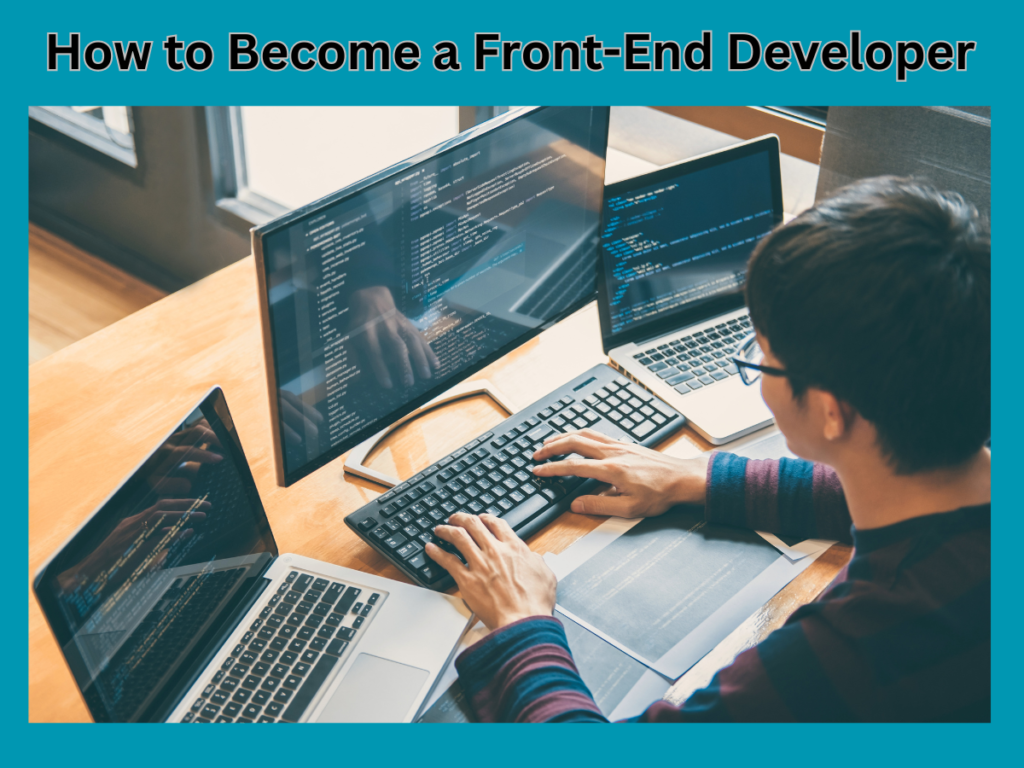In the fast-changing area of technology, the job of a front-end developer is becoming more and more important in shaping the digital world. If you’re interested in how creativity and coding can work together well, becoming a front-end developer could be your next exciting step. This detailed guide will not only help you understand how complicated the front-end development field is, but it will also show you How to become a front-end developer and go from being a beginner to a professional worker.

Understanding the Front-End Universe:
Let’s talk about what front-end development is before we get too technical. Front-end development, which is also sometimes called “client-side development,” makes the visual parts of a website or app that users can interact with. Front-end developers make websites come to life by designing and laying out their layouts and user interfaces.

Steps about How to Become a Front-End Developer
Here are 8 steps about how to become a front-end developer ;
1. Mastering the Foundations:

As with any journey, the first thing you need to do to become a front-end coder is to build a strong base. Before you do anything else, make sure you know how to use HTML, CSS, and JavaScript. HTML sets the structure, CSS adds style, and JavaScript adds interaction. These languages give you the building blocks for all the other skills you will learn in the future.
2. Diving into Frameworks:
It’s the first step on any path to building a strong base, even the path to becoming a front-end coder. Learning HTML, CSS, and JavaScript is the first thing you need to do to start building websites. JavaScript lets you connect with the site, CSS gives it style, and HTML gives it structure. These languages will help you build the skills you’ll need in the future.
3. Responsive Design Mastery:
Responsive design is important in a world where many gadgets are used. Front-end writers need to learn how to make websites that work well on a range of screen sizes and resolutions. Bootstrap and Flexbox are fabulous CSS tools that will help you make a design that looks good on all devices.
4. Version Control with Git:
Because they allow people to work together, version control systems like Git are important for current development. If you know how to use Git, it will be easier to keep your project organized, keep track of changes, and work with other coders. Sites like GitHub and GitLab let you store your projects and work with other coders from around the world.
5. Embracing Build Tools:
Using build tools like Gulp and Web pack can help developers get more done. By handling tasks like code bundling, minification, and optimization, these technologies reduce the amount of work that needs to be done by humans and speed up your apps overall. If you are a worker who cares about accuracy and speed, knowing how to use these tools will make you stand out.
6. Testing and Debugging:
Quality assurance is an essential part of Front-End development. Learn how to develop unit tests using tools like Jest and Mocha to guarantee your code works as it should. Furthermore, mastering debugging techniques and leveraging browser developer tools will enable you to rapidly detect and resolve difficulties.
7. Continuous Learning:
As a Front-End Developer, you need to keep up with the constantly changing digital world. Read business blogs, participate in groups, and go to conferences to stay up to date on new technologies and the best ways to use them. Not only will learning new things all the time help you get better, but it will also make you a more forward-thinking coder.
8. Building a Portfolio:
As you grow, building a portfolio of your projects becomes increasingly important. A well-curated portfolio acts as a visual testament to your abilities and gives actual evidence of your abilities to prospective employers. Include a selection of projects that demonstrate various parts of your Front-End expertise.

Conclusion:
To become a Front-End Developer, you have to keep learning and improving your skills. From learning the basics to figuring out how to use complicated tools, each step helps you become a better coder. Take on challenges, be curious, and get lost in the world of Front-End computing, which is always changing. While you start down this interesting road, remember that the most important thing is that you really want to make great user experiences through code, not just having good technical skills.
